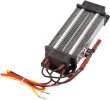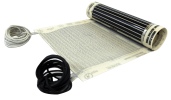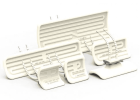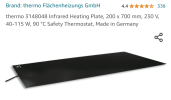brodie7838
New Member
I've looked over many (all?) of the heating solutions being sold for reptile/tortoise enclosures and it sort of seems like the best tools available are Ceramic Heat Bulbs, Deep Heat Projector Bulbs, or Radiant Heat Panels - these options feel a bit underwhelming and definitely not scalable so I started looking at alternatives in their base forms, and I'm curious to see if anyone else has ever gotten creative with their heating (or maybe I'm just overthinking this lol). Here are some ideas I'm considering in my newly-built enclosure:
- Positive Temperature Coefficient heating elements (aka PTC heater, self-regulating heater, car heater): I have a basic 200W version of one of these and while it does its job as advertised, it is not a great accomplice to humidity control unless it were mounted completely enclosed in the space so it was re-circulating existing humid air instead of displacing it. There are many commercial versions featuring this tech available in the form of 'Personal Space Heaters', some of which come in surprisingly small form-factors and either with or without temperature controls, so could be easily set up for individual or centrally-controlled configurations. I figure 2-3 of these 'zoned' together or seperate and paired with some high-quality PWM computer fans could be a good solution, but I'd worry about running all that in such a humid environment long-term.
- Ceramic Infrared Heating Elements: The manufacture(s) that makes all of the different CHE bulbs also makes them in 'panel' and 'plate' forms - circle, square, rectangle, L-shaped, convex, you name it. They're cheap, modular, and could be more readily built into an enclosure than their light-bulb variants, and there are even companies making metal mounts for them that reflect the heat where it's needed. You can get them with or without thermocouplers built-in, so many options for wiring and controlling.
- Radiant Floor Heating: Same tech as the reptile heating mats and the radiant panels, just comes in a roll and you cut it to custom lengths as needed. You can usually find this at local building supply stores and is the easiest to install as well. I like that it would provide the most even distribution of heat, just needs insulation behind it to be thermally effective and a protective veneer in front.
For sure, anything based on a light-bulb socket design is a deal-breaker for me. And I don't believe adequate heating can take place with a single heat emitter, you gotta have more than 1 to achieve the control needed for this, just like a human building.
- Positive Temperature Coefficient heating elements (aka PTC heater, self-regulating heater, car heater): I have a basic 200W version of one of these and while it does its job as advertised, it is not a great accomplice to humidity control unless it were mounted completely enclosed in the space so it was re-circulating existing humid air instead of displacing it. There are many commercial versions featuring this tech available in the form of 'Personal Space Heaters', some of which come in surprisingly small form-factors and either with or without temperature controls, so could be easily set up for individual or centrally-controlled configurations. I figure 2-3 of these 'zoned' together or seperate and paired with some high-quality PWM computer fans could be a good solution, but I'd worry about running all that in such a humid environment long-term.
- Ceramic Infrared Heating Elements: The manufacture(s) that makes all of the different CHE bulbs also makes them in 'panel' and 'plate' forms - circle, square, rectangle, L-shaped, convex, you name it. They're cheap, modular, and could be more readily built into an enclosure than their light-bulb variants, and there are even companies making metal mounts for them that reflect the heat where it's needed. You can get them with or without thermocouplers built-in, so many options for wiring and controlling.
- Radiant Floor Heating: Same tech as the reptile heating mats and the radiant panels, just comes in a roll and you cut it to custom lengths as needed. You can usually find this at local building supply stores and is the easiest to install as well. I like that it would provide the most even distribution of heat, just needs insulation behind it to be thermally effective and a protective veneer in front.
For sure, anything based on a light-bulb socket design is a deal-breaker for me. And I don't believe adequate heating can take place with a single heat emitter, you gotta have more than 1 to achieve the control needed for this, just like a human building.




![premier-garden-soil-0092-64_600[1].jpg](https://data.www.tortoiseforum.org/attachments/355/355937-258bb6429a7a12d2e869275d8008d3a8.jpg)
![burpee-garden-soil-bp8crbl-64_1000[1].jpg](https://data.www.tortoiseforum.org/attachments/355/355938-51b169c997e1bd2c2e12ff829dc53b06.jpg)